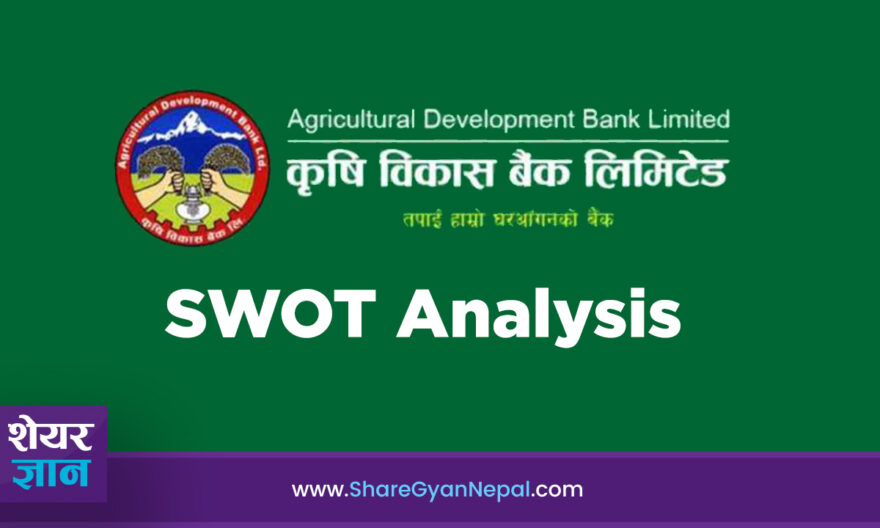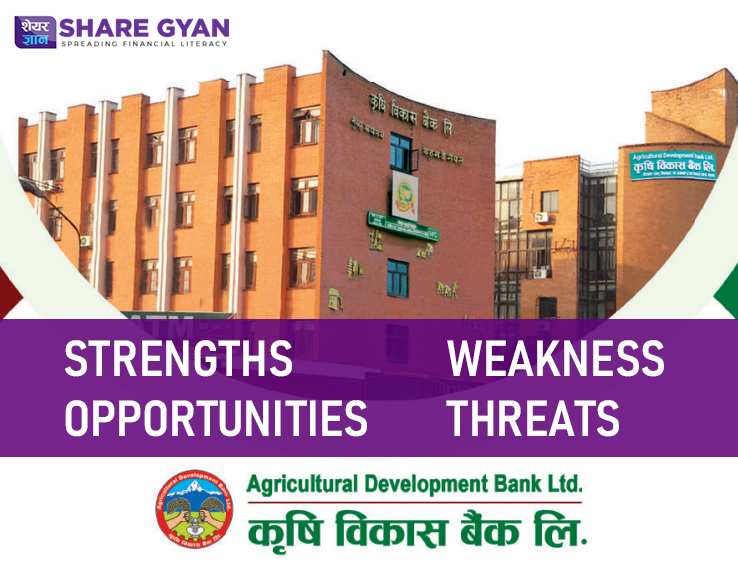
Agricultural Development Bank Limited (ADBL) is the leading bank in the development of agriculture, cottage industry, and small farmer lifestyle. The Agricultural Development Bank was established in BS 2024 to provide institutional credit for enhancing the production and productivity of the agricultural sector in the country. ADBL has played a vital role in the upliftment of deprived sectors, production, and productive fields. As of fiscal year 2081/82, there are 186 branches all across Nepal and have 2670+ total employees.
In this post, we are listing the SWOT analysis of the Agricultural Development Bank.

SWOT Analysis of ADBL (Agricultural Development Bank Ltd.)
Strengths
- Government-owned capital bank
- Huge capital structure
- Mass-based branch network
- Use of modern Core Banking System (CBS)
- A large number of employee
- Huge transaction volume
- Ownership and trust of the customer
- Huge properties (lands, buildings)
- Well known bank among Nepalese people
- Charismatic CEO (Govinda Gurung)
Weaknesses
- Poor managerial sovereignty
- Lengthy and complex internal work procedure
- Complexity in acts, rules, and other legal provisions
- Weak work environment
- Lack of work efficiency and employee motivation
- Unwanted interference by employee union to the management
- Lack of Performance-Based Incentive (PBI) for Active Employees
Opportunities
- Market expansion and financial access
- Expansion of transactions through government transaction
- Efficient and effective service delivery through young and energetic human resources
- Increasing use of IT in the field of banking service delivery
- Expansion of the market with modern banking facilities
- International market expansion due to amendment in banking law
- Achieving a leading role in the agriculture development sector
- Providing lending opportunities in rapid physical infrastructural development
Threats
- High competition in the market due to the implementation of IT
- Automation in the banking service system
- Challenges of capacity development empowering employees in bureaucratic structure
- Challenge of cost-cutting in branch expansion
- Market expansion because of limited market and large number of players
- Achieving continuous profit in a competitive environment
- Challenge to promote Internal control and corporate governance in the bank
These are the Strengths, Weaknesses, Opportunities, and Threats of the Agricultural Development Bank (ADBL). The management must thoroughly analyze these points to achieve more success in the future.
What is SWOT Analysis?
If you are searching for the term SWOT, then you might have an idea of what it is.
SWOT analysis is a strategic planning tool used to assess the internal and external factors that can influence the performance of a business, organization, or individual. SWOT stands for Strengths, Weaknesses, Opportunities, and Threats.
Here’s a breakdown of each component of SWOT analysis:
- Strengths: These are the positive internal attributes or resources that give an entity a competitive advantage over others. Strengths could include factors such as strong brand recognition, skilled employees, superior technology, loyal customer base, or efficient processes.
- Weaknesses: These are the internal factors that put an entity at a disadvantage compared to others. Weaknesses may include factors like lack of expertise, limited resources, poor infrastructure, ineffective marketing strategies, or outdated technology.
- Opportunities: These are the external factors or situations that can be exploited to the entity’s advantage. Opportunities arise from market trends, emerging technologies, changes in regulations, new customer segments, or untapped markets. Identifying and leveraging opportunities can lead to growth and competitive advantage.
- Threats: These are the external factors or challenges that could negatively impact the entity’s performance. Threats may include intense competition, changing consumer preferences, economic downturns, new regulations, technological disruptions, or supplier issues. Identifying threats helps in developing strategies to mitigate or overcome them.
SWOT analysis is typically conducted by gathering relevant information, brainstorming and evaluating strengths, weaknesses, opportunities, and threats, and using the insights gained to develop strategies and make informed decisions. It is a versatile tool that can be applied to various situations, including business planning, project management, product development, marketing campaigns, personal development, and more.

Other Posts
- ADBL – Establishment, Development, Work Nature, Mission, Vision & Objectives
- What is KYC (Know Your Customer) in Banking?
- RBB 4th & 5th Old Question Paper Collection
- What is Deposit and its Types
- ADBL Computer Officer Question Model

